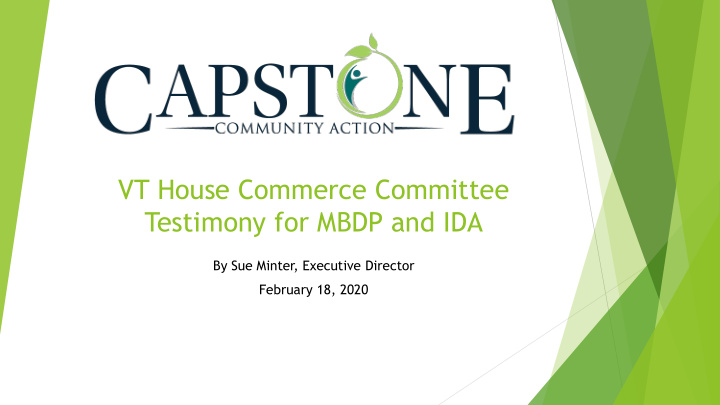



VT House Commerce Committee Testimony for MBDP and IDA By Sue Minter, Executive Director February 18, 2020
BROC – Community Action in Southwestern Vermont 45 Union Street, Rutland Serving Bennington and Rutland counties Capstone Community Action 20 Gable Place, Barre Serving Washington, Orange and Lamoille counties, six towns in northern Windsor county, and the towns of Pittsfield, Hancock and Granville. CVOEO – Champlain Valley Office of Economic Opportunity 255 South Champlain Street, Burlington Serving Chittenden, Franklin, Grand Isle & Addison counties. NECKA – Northeast Kingdom Community Action 70 Main Street, Newport & 115 Lincoln St, St. Johnsbury Serving Caledonia, Essex and Orleans counties. SEVCA – Southeastern Vermont Community Action 91 Buck Drive, Westminster Serving Windham county and most of Windsor county.
From 2006- 2016, US Poverty rate stable, yet Vermont’s poverty rate increased by 2% over the decade. Poverty in Vermont increased while overall Vermont economy improved.
What’s a livable wage in Vermont? The Vermont Livable Wage is defined in statute as the hourly wage required for a full-time worker to pay for one-half of the basic needs budget for a two-person household, with no children, and employer-sponsored health insurance, averaged for both urban and rural areas. The 2018 Vermont Livable Wage is $13.34 per hour
The Micro Business Development Program (MBDP) Since 1989, MBDP has provided free business technical assistance (training and counseling) and access to capital to low-income Vermonters. The Vermont Community Action Agencies (CAAs) work in conjunction with many partners, including other service providers, state agencies, business technical assistance providers, and lenders, both alternative and traditional. Each year , an average of 115 businesses are started or expanded across Vermont, 86 new jobs are created, and more than $1 million in capital is accessed. The State base funding for MBDP is about $298,870. In each of the last three years the Legislature has invested an additional $100,000 in “one - time” funds in the program. The ten -year average cost per job is less than $3,800. Vermont Matched Savings Program (Individual Development Accounts-IDA) Established with the creation of 33 V.S.A.§1123 in 2000, the Legislature has invested annually in the matched savings (IDA) and financial education program that helps low-income Vermonters invest in their future by enabling them to build financial assets. Program participants save — and receive matched funds from the State — to purchase or repair a home, invest in job training or post-secondary education, or start and grow a business, while also increasing their financial knowledge. Since 1997 with the inception of Federal IDAs, 1,030 Vermonters have saved and invested $2,819,555 in their future, much of which has helped support their local economy. Of those, 605 have invested in businesses, 257 in education, and 224 in first-time homeownership. State funding for the IDA program in each of the past two years has been $170,000 to match the savings of participants and provide the financial education. In the last 5 years, across Vermont, these programs have achieved the following: • 3,666 low income Vermonters were served • 682 Business starts and expansions • 429 Jobs created • 237 IDA Savings Accounts opened • $5,568,102 capital leveraged
Sue Minter Executive Director Capstone Community Action 20 Gable Place, Barre, VT 05641 (802) 479 -1053 www.capstonevt.org Find us on Facebook, Twitter and Instagram
Capstone Community Action’s Impact Video
Recommend
More recommend